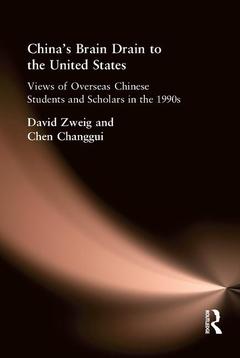China's Brain Drain to the United States
Auteurs : Zweig David, Changgui Chen

Date de parution : 02-2017
15.6x23.4 cm
Mots-clés :
chinese; students; home; unit; green; cards; tiananmen; incident; president; bush's; Chinese Government; Parental Background Characteristics; Chinese Student Protection Act; Chinese Communist Party; Foreign Broadcast Information Service; President Bush's Executive Order; Canadian International Development Agency; Limited Job Mobility; Key Researchers; Personal Development; Long Term Sojourners; Non-returning Students; Common Language; United States; Home Units; Brain Drain; Park Chung Hee; Tiananmen Incident; Overseas Chinese Students; China's Researchers; Low Return Rates; State Education Commission; Girl Friend; Negative Relationship; High Tech Industrial Parks



